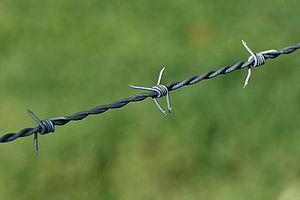 Image via Wikipedia
Image via Wikipedia
Barbed wire fences have many enemies. It is really not unusual for a tree which is leaning away from the fence at a 45 degree angle to suddenly reverse its lean and fall directly on the wire. In such cases the repair involves a chainsaw and several posts. The wire, being stretched significantly by the tree becomes very loose in all directions and must be tightened. There is not enough wire present to join together with a twist, so you must always patch in a short piece of wire - making the resultant fence an engineering marvel, but an artist's eyesore. Other enemies of fences are hunters who wreck them for no reason at all, bulls and large cows who just have to have the grass on the other side and time which rusts the most expensive wire and rots the most resilient posts. If you own one mile of exterior (or perimeter) fence; odds are that at any given moment there is a weak spot or hole in it. Many times the hole will be large enough for 5 cows to elope with the neighbor's bull at the same time.
A cow that leaves through a hole in the fence will remember that place and return home - most of the time. However, before the prodigal decides to "make nice" she will generally leave a large pile of cow droppings in someone's rosebed, or trample an acre of sweet corn in order to get to the other side, or especially if she is completely black in color, she will have to stand in the road at night. And most neighbors and motorists are really not that understanding. A lot of times they want you to pay them for the damages! Sometimes they incarcerate your cow in a barn and keep her until you fix or pay for the damages! Many times, county law becomes involved making any serenity that you may have go up in flames.
I guess I don't know which is the worse - cows or fences...

![Reblog this post [with Zemanta]](http://img.zemanta.com/reblog_e.png?x-id=af65dc5e-4004-4b23-bf73-55e14f4c9592)
No comments:
Post a Comment